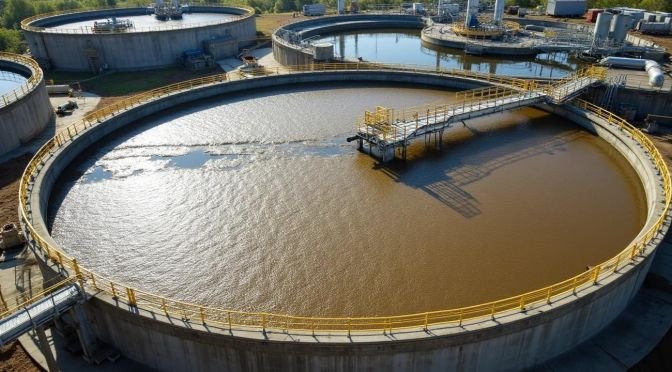Sludge processing through drying beds can reduce moisture content from the original 95-98% down to 60-70%. The results vary based on climate conditions and bed design. These simple yet effective dewatering systems are vital to wastewater treatment facilities worldwide. The process takes 10-15 days in warm climates but might need several weeks in colder or humid regions.
Sludge drying beds work through two main dewatering mechanisms: evaporation and drainage. The system’s performance depends on proper design dimensions and operational practices. Conventional sludge drying beds measure 6 meters wide and 6-30 meters long, with sand layers between 230-300mm deep. The complete sludge treatment process flow helps optimize performance. Loading rates for these beds (100-300 kg dry solids/m²/year for uncovered beds) are much lower than other dewatering methods. This piece gives expert knowledge about designing, operating, and maintaining sludge drying beds that will help you get the best results in your wastewater treatment facility.
Understanding Sludge Drying Beds in Wastewater Treatment

Sludge drying beds stand among the oldest and most common methods to dewater sludge in wastewater treatment facilities. These systems work best for small to medium-sized communities that have available land for implementation.
Definition and Role in Sludge Processing
A sludge drying bed consists of a shallow, rectangular structure with layers of sand and gravel, plus drainage pipes underneath. These beds function as natural, affordable dewatering systems that separate solids from liquids in sludge. They reduce sludge volume and prepare residuals for final disposal or additional processing. This volume reduction plays a vital role since wastewater treatment plants produce massive quantities of sludge, especially in growing populations.
The design and application of sludge drying beds fall into several categories:
- Conventional sand beds (most common for municipal sludge)
- Paved drying beds (improved for industrial applications)
- Artificial media beds
- Vacuum-assisted beds
- Solar-enhanced drying beds
Drainage and Evaporation Mechanisms
Two fundamental mechanisms work together to make sludge drying beds effective. Water first percolates downward through sand and gravel layers into the underdrain system. This first phase removes free water within 24-48 hours after application. Sunlight and air movement then dry the remaining sludge through evaporation. Studies show that evapotranspiration leads water loss, followed by vertical drainage as the second most significant process.
The sand’s uniformity (coefficient not over 4.0) and its effective size (0.3 to 0.75 mm) determine drainage efficiency. The piping to the beds must maintain a minimum velocity of 0.75 m/s to avoid clogging.
Sludge Treatment Process Flow Diagram Overview
Sludge drying beds operate after stabilization and thickening stages in the wastewater treatment process. The dewatering begins once the sludge completes its original processing. The process flows through these steps:
- Sludge application in 20-30 cm layers
- Initial drainage phase (1-2 days)
- Extended evaporation phase (10-15 days total drying time)
- Manual or mechanical removal of dried sludge (60-70% moisture content)
The dried sludge can then go to disposal, serve as compost, or undergo additional processing based on its characteristics and intended use.
Types of Sludge Drying Beds and Their Use Cases
The rise of sludge drying bed technology has led to several specialized variants that handle specific operational needs and limitations. Each type works best in different situations, depending on local conditions, available resources, and processing needs.
Conventional Sand Beds for Municipal Sludge
Sand drying beds are still the most popular dewatering solution for small and medium-sized wastewater facilities. These rectangular structures are usually 6m wide and 6-30m long with sand layers 230-300mm deep. The sand needs a uniformity coefficient below 4.0 and an effective size between 0.3-0.75mm to drain properly. Municipal plants can process 100-300 kg dry solids/m²/year on uncovered beds.
Many Indian cities show how well these systems work. Treatment plants in Patna (Beur and Saidpur) use sand drying beds that each hold 405m³. Plants of all sizes in Gujarat state have also added this technology to their treatment systems.
Paved and Artificial Media Beds for Industrial Use
Paved drying beds use concrete, asphalt, or soil cement instead of sand. These beds have a 20-30cm thick sand or gravel base that slopes at least 1.5% toward drainage areas. This design makes it easier to remove sludge mechanically without damaging underdrains or losing sand media.
Real-world results show that paved beds dry sludge faster and cost less to run than regular sand beds. These improved paved beds can reach 47% solids content in just 12 days, while regular beds only reach 16% during the same time.
Artificial media beds use materials like geotextiles, porous tiles, or wedge-wire screens rather than sand. These materials drain faster and clog less often. They work really well with industrial sludges that contain grease or coarse materials.
Vacuum-Assisted and Solar Beds for Urban Constraints
Vacuum-assisted beds speed up dewatering by adding vacuum pumps to the drainage system. They cut processing time in half compared to regular beds, which makes them perfect for crowded urban areas. The system creates vacuum pressure (3-34 kN/m²) after the sludge covers the bed surface and reaches 12% solids concentration in just 24 hours without needing polymers.
Solar drying beds take an innovative approach by combining greenhouse design with mechanical mixing equipment. These systems keep internal temperatures above 15°C when there’s sunlight, even in freezing weather. A facility near Salt Lake City runs all year round and dries sludge from 18% to 70% using just solar energy.
Design Parameters for Efficient Drying Bed Operation
The success of sludge drying beds depends on exact engineering design parameters. My experience shows that careful attention to dimensions and material choices directly affects how well these beds work and how long they last.
Optimal Bed Dimensions and Sludge Loading Depth
Well-sized beds work efficiently and need less land. Standard sludge drying beds measure 6-8 meters wide by 30 meters long. Single-point sludge application works best when the length stays under 30 meters with a bed slope of 0.5%. The best loading depth ranges from 20-30 cm per batch. A mere 10 cm increase in depth can double the drying time. Tropical climates can handle loading rates between 100-200 kg TS/m²/year, while temperate regions need lower rates around 50 kg TS/m²/year.
Sand and Gravel Media Specifications
Sand selection is vital for effective dewatering. The sand layer needs to be 20-30 cm thick with an effective size between 0.3-0.75 mm and a uniformity coefficient below 4.0. Waste activated sludge works best with sand sizes between 0.5-0.8 mm. Trickling filter sludge needs coarser sand ranging from 0.8-3.0 mm.
The gravel media beneath needs specific gradation:
- Bottom layer: Coarse gravel (20-40 mm diameter), 15-20 cm thick
- Intermediate layer: Medium gravel (5-15 mm), 10-15 cm thick
- Top gravel layer: Fine gravel (3-6 mm), minimum 75 mm thick
Drainage System Design and Slope Requirements
Underdrain systems work with perforated pipes that need a minimum 10 cm diameter. Pipes should be spaced no more than 6 meters apart, and the bed needs a minimum slope of 1-2% toward drainage points. Thin sludge flowing by gravity works better with a steeper 3% slope.
Climate Adaptation: Covered vs. Open Beds
Climate plays a major role in how well drying beds perform. Open beds work well in warm, dry regions with cycle times around 2 weeks. Cold or rainy climates need covered structures that extend cycle times to 3-6 weeks. These covered beds shield against rainfall and boost evaporation rates through greenhouse effects.
Operational Best Practices and Maintenance Guidelines
Daily operations can make all the difference between quick sludge processing and frequent system failures. Our experience shows that focusing on loading techniques and regular maintenance extends bed lifespans by a lot.
Sludge Loading and Distribution Techniques
The success of sludge processing starts with the right loading practices. You should apply sludge in uniform layers of 20-30 cm depth. The drying time increases by 50-100% when this thickness is exceeded. Pre-thickening sludge through gravity thickeners or dissolved air flotation before application reduces drying cycles by 30-40%. Multiple inlet points help distribute the sludge evenly and prevent localized pooling.
Monitoring Moisture Content and Drying Time
Optimal bed performance needs regular moisture monitoring. The target drying period usually takes 10-15 days with a final moisture content of 60-70%. In spite of that, climate conditions and sludge characteristics can change these numbers. You should use moisture meters or grab samples to check when sludge reaches the optimal 25% TS content to remove. The evaporation factors ((100 – Air humidity) × Air temperature) help predict drying times.
Odor and Vector Control Measures
We noticed that odor problems start during sludge processing, with over 36% of WWTP odor emissions coming from dewatering and drying. The best way to curb this is maintaining aerobic conditions, avoiding sludge storage beyond 3-4 days, and adding lime. Covering beds with netting stops flies and mosquitoes from becoming a problem.
Sand Clogging Prevention and Media Replacement
Sand loss reaches 6 cm per bed for every 14 drying cycles. Porous tiles can reduce sand loss to negligible levels. Sand diameter is vital—smaller diameters (0.1-0.5 mm) reduce clogging risk compared to larger particles (1.0-1.5 mm). The right time to replace sand comes when organic matter accumulation becomes visible, usually after 5-10 drying sequences.
Conclusion
Sludge drying beds are among the most reliable and budget-friendly options for wastewater treatment facilities worldwide. This piece explores the simple aspects of these dewatering systems, from their core mechanisms to advanced design choices. Without doubt, drainage and evaporation work together to cut moisture content substantially. The original sludge with 95-98% moisture becomes a manageable 60-70% in just 10-15 days when conditions are right.
Different drying bed types serve specific purposes based on local needs. Municipal facilities still rely on conventional sand beds, while industrial applications benefit from paved and artificial media beds. On top of that, vacuum-assisted and solar beds work well for facilities with space limits or tough climate conditions.
Design parameters directly affect how well these systems work. The recommended bed dimensions, proper sand and gravel specs, and quick drainage systems should be your priority. Climate factors help determine whether covered or open beds will give the best results for your facility.
Daily operations shape the system’s long-term success. So, operators should focus on loading techniques, moisture checks, and maintenance. Good odor control and preventing sand clogs help extend bed life and keep processing smooth.
Becoming skilled at sludge drying bed design and operation helps treatment facilities deliver steady, reliable results while keeping costs in check. Water treatment professionals must balance tried-and-true methods with new approaches to handle growing waste processing needs. These simple yet effective sludge drying beds will keep playing a key role in sustainable wastewater management for years ahead.
Key Takeaways
Master these essential principles to optimize your sludge drying bed performance and achieve consistent dewatering results in wastewater treatment operations.
• Optimal loading depth of 20-30 cm is critical – exceeding this thickness can increase drying time by 50-100%, significantly impacting operational efficiency.
• Sand specifications directly impact drainage performance – use effective size 0.3-0.75 mm with uniformity coefficient below 4.0 for proper water percolation.
• Choose the right bed type for your application – conventional sand beds work for municipal sludge, while paved beds offer superior performance for industrial applications.
• Climate adaptation determines system design – open beds work in warm, dry regions (2-week cycles), while cold/rainy climates require covered structures (3-6 week cycles).
• Regular maintenance prevents costly failures – monitor sand loss (6 cm per 14 cycles), replace clogged media after 5-10 sequences, and maintain proper drainage slopes of 1-2%.
Proper implementation of these design and operational principles can reduce sludge moisture content from 95-98% down to 60-70% within 10-15 days, making drying beds a reliable, cost-effective solution for sustainable wastewater management.
Frequently Asked Questions
Q1. What are the main mechanisms involved in sludge drying beds?
Sludge drying beds primarily utilize two mechanisms: drainage and evaporation. Initially, water percolates through sand and gravel layers into an underdrain system. Then, sunlight and air movement further dry the remaining sludge through evaporation.
Q2. How long does the sludge drying process typically take?
The sludge drying process usually takes between 10-15 days in warm climates. However, this duration can extend to several weeks in colder or more humid regions, depending on local weather conditions and bed design.
Q3. What are the optimal dimensions for a conventional sludge drying bed?
Conventional sludge drying beds typically measure 6 meters wide and 6-30 meters long. The sand layer depth usually ranges from 230-300mm. These dimensions are designed to maximize dewatering efficiency while minimizing land requirements.
Q4. How often should the sand in a drying bed be replaced?
Sand replacement is necessary when organic matter accumulation becomes evident, typically after 5-10 drying sequences. On average, sand loss is about 6 cm per bed for every 14 drying cycles, so regular monitoring and maintenance are crucial.
Q5. What are some methods to control odor in sludge drying beds?
To control odor, maintain aerobic conditions in the beds and avoid storing sludge for more than 3-4 days. Adding lime can also help reduce odors. Additionally, covering beds with netting can prevent flies and mosquitoes, which can contribute to odor issues.






